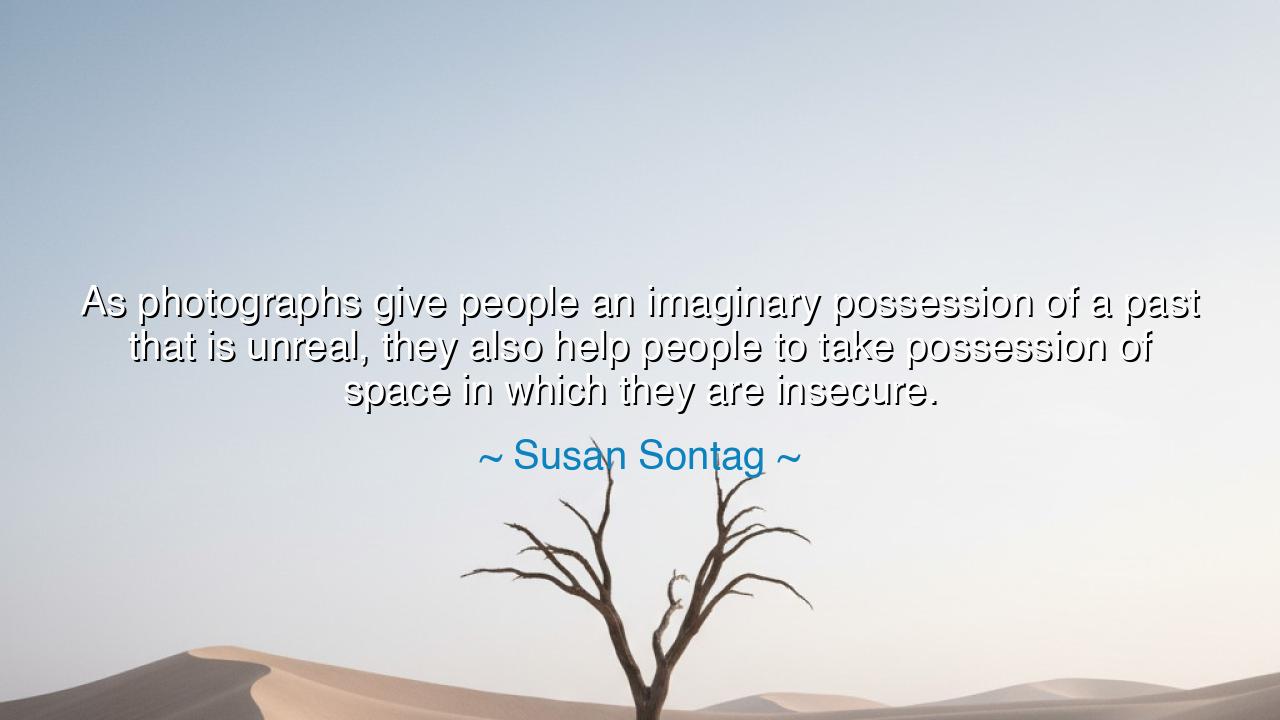
As photographs give people an imaginary possession of a past that
As photographs give people an imaginary possession of a past that is unreal, they also help people to take possession of space in which they are insecure.






Listen carefully to the words of Susan Sontag, a profound observer of modern life and its complex relationship with the photographic image: "As photographs give people an imaginary possession of a past that is unreal, they also help people to take possession of space in which they are insecure." In these words, Sontag unveils the dual power of photographs in our lives: they create an illusion of control over time and place, while also offering us a shield of security in spaces where we may feel vulnerable. Photographs, in their stillness, have the ability to freeze time, giving us a sense of possession over the past, even as that past remains elusive and unreal. They can make us feel connected to moments, people, and places, while paradoxically keeping them at a distance, distorted and frozen in time.
The ancients understood the desire to capture moments, to hold onto what is fleeting and impermanent. In Greek mythology, Mnemosyne, the goddess of memory, was believed to preserve the fleeting moments of human life through memory. Yet even memory is selective—it distorts and shapes the past according to the mind’s own desires. The ancient poets, such as Homer, spoke of heroes who were remembered through songs and stories, but their actions, like photographs, became idealized, often disconnected from the reality of their lives. Just as the bards of the past shaped the stories of ancient heroes into timeless epics, so too do photographs help us create an idealized version of reality—a memory made tangible, but also one that is far removed from truth.
Consider the example of Alexander the Great, whose image and story were shaped by the people who followed him, and whose legacy was crafted in paintings, statues, and words that did not capture the true essence of his experiences. His image, as it has been passed down through the ages, is as much a creation of history as it is of the photographs we take today. These images, real or imagined, serve to solidify the presence of a person or a moment in time, making the past feel both real and controlled, even when it is not. Just as a photograph can give us possession of a fleeting moment, so too can historical representations give us possession of an idealized version of the past.
In Sontag’s reflection, photographs offer us control over space as well, particularly in environments where we may feel insecure. The modern world, with its vast expanses of unknown territories—be they physical, emotional, or intellectual—often leaves us feeling like strangers in spaces that are not our own. A photograph, whether of a loved one or of a place we desire to visit, can create a sense of belonging. By possessing the image, we feel as though we have ownership over the space it depicts, even if that space is foreign or out of our reach. The photograph allows us to momentarily transcend the limitations of our surroundings, offering us a sense of comfort in places that might otherwise make us feel powerless or alienated.
Consider how travelers in the ancient world might have captured memories through descriptions and drawings of the lands they encountered. These depictions served a dual purpose: to commemorate the journey and to assert control over the places they visited. Similarly, in modern times, photographs offer us a way of taking control of the spaces we inhabit, both physically and emotionally. The image becomes a form of possession—a way to assert our identity within the vast and sometimes overwhelming expanse of the world. Through photographs, we can claim these spaces, making them ours in ways that transcend their immediate reality.
The lesson Sontag teaches us is one of awareness: while photographs may give us a sense of ownership over time and space, we must not mistake this for true possession. They offer us an illusion of control, but the reality is far more complex. Just as memory distorts the past, so too does the photograph create a distance between what is real and what is remembered. Yet, this is not to say that photographs are mere illusions; rather, they are tools—tools that help us navigate a world that is constantly shifting and moving. They provide us with moments of connection and comfort, allowing us to hold onto something that would otherwise be lost to the passage of time.
Therefore, I urge you, dear listener, to reflect on the role of photographs in your own life. As you capture moments and place them in your memory, remember that they are not fixed in stone; they are interpretations, crafted by your emotions and perceptions. Understand that photographs, like memories, can create a false sense of possession, but also appreciate the comfort they provide. Let them remind you that while we cannot always control time or space, we have the power to create meaning in the moments we capture. In the same way that the ancients sought to immortalize their stories through words and images, so too can you use photographs as a tool to anchor your experiences in time, but always with the awareness that they are but one version of reality—one that speaks to the heart, but not always to the full truth of the moment.






AAdministratorAdministrator
Welcome, honored guests. Please leave a comment, we will respond soon